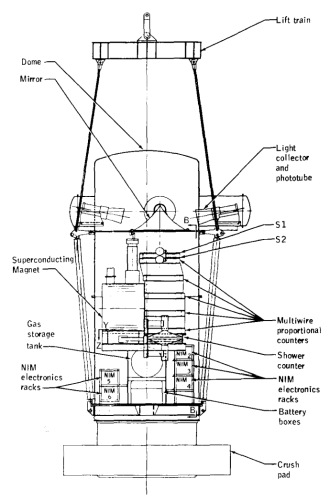Purpose of the flight and payload description
The objective of the balloon flight was to search for antiprotons in the cosmic rays using a superconducting magnet spectrometer developed by the Physical Science Laboratory in Las Cruces based on a previous apparatus developed by the same scientific group at the NASA's Johnson Space Center.
A basic scheme of the magnet spectrometer and the container gondola is shown in the figure at left (click to enlarge). The spectrometer has two main components: the SUPERCONDUCTING MAGNET and the MULTIWIRE PROPORTIONAL COUNTERS (MWPC) stack. The magnet was a scaled-up version of the first superconducting magnet to fly successfully on a balloon by the NASA JSC group back in 1969-1970. The new magnet was 61 cm in diameter and produced a magnetic field of ~40 kilogauss at the center of the coil when operating at a current of 120 Amperes. It weighed 150 kg and was maintained at a temperature a few degrees above the absolute zero inside a cryostat cooled by liquid helium. The purpose of the magnet was to deflect the course of heavy particles reaching the detector from outer space, so that the charge and momentum of each particle -its characteristic signature- can be measured.
The MWPC stack, for this flight consisted of five identical 50 x 50 cm2 MWPCs modules (increased to eight modules in later flights) staggered horizontally so that the top chambers are closer to the magnet face. The MWPCs position measurements were digitized using distributed inductance delay lines coupled to the chamber wires. The chambers were oriented with the anode wires perpendicular to the magnet axis so that most of the bending in the magnetic field occurs along the cathode coordinate axis. Position measurement, in each coordinate axis, was obtained by measuring the time of arrival of the signal at each end of the delay lines.
A gas Cherenkov counter, was located above the MWPC stack. The detector was filled with air or sulfur hexafluoride depending on the flight objectives. Its aperture was divided equally by four spherical mirrors, each of which was viewed by a 12.5 cm diameter RCA 4525 photomultiplier (PM) tube through a conical mirror that acted as a high transmission lens. The overall length of this detector was 1 meter, with an effective path length of 80 cm.
All scintillators, S1, S2, P1-P7, were 0.6 cm thick Pilot Y. Scintillators S1 and S2 were each viewed by two 5 cm diameter RCA 4523 PM tubes through two adiabatic light pipes, and all other scintillators were viewed by single RCA 4523 PM tubes through conventional light pipes. Except for P1, which was 45 x 45 cm2, all of the scintillators were 50 x 50 cm2. The scintillators P1 - P7 were each separated by 1.2 radiation length of lead thereby forming a shallow shower counter of 1.2 radiation lengths depth. This counter provided a rough energy determination (30%) of the electron events and was crucial in reducing the proton contamination of positron measurements.
The signals from the scintillators and the Gas Cerenkov system were pulse height analyzed and digitized with 12-bit resolution. These values, along with the outputs from the MWPC time digitizers, were telemetered and recorded on ground along with a flag to indicate the type of coincidence event. In addition, the time of flight between S1 and P1 was measured to determine the direction of motion of the incoming particle. The digitized data, together with 100 channels of sub-commutated engineering data (voltages, temperatures, pressures and logic state) were transmitted to the ground via a 48 kbit/s telemetry link. A 100-channel command link was used to control the payload on the ground and during flight.
The availability of the data in real time, and the possibility of actively controlling discriminators, detector voltages and logic circuitry pushed the development of a mini-computer based real-time data processing and experiment control system. A data van equipped with a Digital Equipment Corporation PDP-8E and PDP-11/10 computers was used for interactive payload control. Scientific data was presented to the experimenters in graphic and tabular form. Information was also available for examination in real-time on pulse height spectra, MWPC resolution, etc. Commands were issued to the payload to control the logic and detector operating conditions in order to optimize key parameters (e.g., chamber resolution and experiment dead-time). All commands were issued by the computers in response to keyboard mnemonics typed by the observing teams. In a typical flight about one hundred keyboard command sequence mnemonics were typed. These result in roughly one thousand actual two-digit commands being sent to the payload. Experience from first flights demonstrated that this interactive control technique was an invaluable aid in achieving high quality data from the payload.
The instrument and all its components, including electronics and batteries were encased in an insulated gondola 5 meters tall and 2.4 meters in diameter with a total mass of 2100 kg.
Details of the balloon flight
Balloon launched on: 9/23/1975
Launch site: Columbia Scientific Balloon Facility, Palestine, Texas, US
Balloon launched by: National Scientific Balloon Facility (NSBF)
Balloon manufacturer/size/composition: Zero Pressure Balloon Winzen 612.093 m3 (22.86 microns - Stratofilm)
Flight identification number: 922P
End of flight (L for landing time, W for last contact, otherwise termination time): 9/23/1975
Landing site: Balloon failure at launch
Payload weight: 2889 kgs.
No data obtained due to balloon failure
External references
- National Scientific Balloon Facility Annual Report FY 1976 National Center for Atmospheric Research, March 1977
- The proton and helium rigidity spectra from 10 to 100 GV 15th International Cosmic Ray Conference, Vol. 11. 1978, p. 155
5572If you consider this website interesting or useful, you can help me to keep it up and running with a small donation to cover the operational costs. Just the equivalent of the price of a cup of coffee helps a lot.


